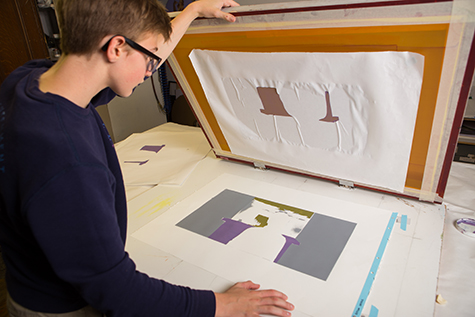ChatGPT said: Finding the best deals with 10:9 Design near me: tips
Wiki Article
The Crucial Overview to Recognizing Screen Printing and Its Versatile Uses
Screen printing has an abundant history that dates back to old times, advancing right into an innovative technique utilized across numerous markets today. This overview explores the ins and outs of the screen printing procedure, detailing its applications in home, advertising and marketing, and style decoration - 10:9 Design Screen Printing Texas. Understanding these principles can open up creative capacity for both artistic and business tasks. The following sections will reveal vital suggestions and methods to boost one's screen printing venturesThe History of Screen Printing
Although screen printing has origins that trace back centuries, its advancement mirrors the technical and imaginative improvements of numerous cultures. Stemming in old China, the method was originally used for embellishing textiles and later spread to Japan, where it came to be essential to Ukiyo-e woodblock printing. The method changed to Europe in the 18th century, where it obtained appeal among craftsmens and business printers. The invention of picture emulsion in the 20th century revolutionized screen printing, enabling even more detailed layouts and greater performance. Artists like Andy Warhol better drove its appeal, making use of the tool to produce famous jobs that combined commercialism and fine art. By the late 20th century, screen printing had actually established itself as a versatile strategy, used in style, marketing, and art. Today, it remains to evolve, incorporating electronic modern technology and expanding its applications across numerous industries.The Screen Printing Process Explained
Screen printing changes artistic visions right into concrete designs through a series of exact steps. An image is developed and after that transferred onto a screen, usually made of fine mesh textile stretched over a framework. A light-sensitive solution is used to the screen, which is exposed to light, solidifying in locations not covered by the photo. After washing out the unhardened solution, a pattern is created.Next, the screen is positioned over the substratum, whether it be material, paper, or another product. Ink is then pressed through the open locations of the stencil using a squeegee, transferring the design onto the substratum listed below. This process can be duplicated for several colors, calling for different displays for every hue. The published product is cured utilizing heat to guarantee the ink adheres appropriately, resulting in a long lasting, vivid style prepared for usage.
Types of Screen Printing Techniques

Furthermore, specialty techniques, such as discharge screen printing, eliminate dye from the textile to develop softer prints, while foil screen printing uses metallic foil to attain a shiny finish (10:9 Design Screen Printing Texas). Each technique provides distinctive attributes, dealing with various creative requirements and production scales, inevitably expanding the opportunities within the screen printing domain
Applications of Screen Printing in Various Industries

Additionally, the signs and marketing sectors use screen printing for creating attractive displays and banners. This method permits strong colors and complex layouts that catch attention. In electronics, screen printing is used for applying conductive inks to circuit boards, vital for part links. The home décor sector embraces screen printing to generate distinct designs on textiles and wall surface art. On the whole, screen printing works as an essential device across diverse areas, improving items with personalized and aesthetically appealing graphics.
Tips for Successful Screen Printing Projects
While taking on a screen printing task, cautious attention to information can substantially enhance the last result. Choosing top notch products is vital; this consists of the screen, inks, and substrates. Utilizing suitable mesh counts can influence ink deposition and information resolution. Preparation is similarly crucial; comprehensive cleaning of displays and correct exposure times ensure crisp prints.Next, exact enrollment is important for multi-color prints. Making use of placement devices can help attain exact layering. Additionally, screening prints on scrap products before manufacturing aids determine potential issues without losing resources.

Often Asked Concerns
What Products Are Best for Screen Printing on Fabric?
Cotton and polyester blends are perfect for screen printing on fabric because of their durability and ink absorption. Furthermore, specialized materials like silk or canvas can create special appearances and finishes, enhancing the general design quality.Just how Do I Clean and Maintain Screen Printing Devices?
To preserve and clean screen printing equipment, one should on a regular basis wash screens with proper solvents, examine squeegees for wear, lubricate moving components, and shop all things in a completely dry, dust-free environment to prolong their life-span.What Are the Environmental Effects of Screen Printing?
Screen printing can have considerable ecological influences, consisting of chemical waste from solvents and inks, water usage throughout cleansing procedures, and energy intake. Lasting practices and eco-friendly materials are important for reducing these negative impacts.Can Screen Printing Be Done in the house Properly?
Screen printing can be successfully done at home with the appropriate products and read more methods. Enthusiasts can create top quality prints, though success relies on their ability degree, tools, and understanding of the process involved.
What Are the Costs Connected With Beginning a Display Printing Organization?

Starting a screen printing business includes prices for equipment, products, and office. Initial expenditures normally range from a couple of hundred to a number of thousand bucks, relying on the scale, high quality of machinery, and desired production capacity.
Screen printing has an abundant history that dates back to old times, developing into an advanced method used across different industries today. Another method, rotary screen printing, uses round screens, assisting in constant printing on fabric rolls, consequently enhancing efficiency for large productions. Additionally, specialty methods, such as discharge screen printing, remove dye from the fabric to develop softer prints, while aluminum foil screen printing uses metallic foil to attain a glossy finish. In the style market, screen printing is commonly used to develop vivid designs on clothing, allowing brand names to showcase their one-of-a-kind styles. Cotton and polyester blends are ideal for screen printing on textile due to their resilience and ink absorption.
Report this wiki page